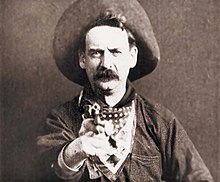Great Train Robbery, The (1903)
 Edison Manufacturing Company
Edison Manufacturing CompanyDirector: Edwin S. Porter
Honors: National Film Registry
For my first film where was I to begin? Motion pictures have been around since the 1880s and around the late 1890s (1898 as the American Film Institute would claim) people started paying for the privilege of watching these moving pictures as a source of entertainment. At first these films were of simple, everyday things.
Take for example The Kiss (1896) which was distributed by Thomas Edison. (That is right, the same man that invented the light bulb. Edison was a great contributer to the beginnings of motion pictures as well as one of it's greatest villains, as he tried to stop anyone else from making motion pictures too.) The film depicted nothing more than a mustachioed man embracing and kissing a woman. It was only 47 seconds long. At the time the film was seen as offensive, such public display of affection projected on a large scale was appalling to the audiences of the time who had seen nothing like that on film. Motion pictures were simple and short. These images showed factory workers leaving work, traffic in New York, or a train entering or leaving a station. To a simpler time these were ways for people to see the distant places or things. Also it was a thrill to see picture, which were only still photographs up until then, start to move as if they were alive. Audiences flocked to see this marvel. It was only a short time until filmmakers would put stories into these pictures.
And now, The Great Train Robbery.
This wasn't the first film to put a narrative to a motion picture, but it was a significant step in how the motion picture was to be used to tell stories. A masterpiece of its time, with a running time of a whopping 12 minutes! The film utilized many revolutionary techniques for its time including a strong use of editing (as films then usually were short and were one take, or maybe an edit or two), double exposure, shooting on location, camera movement (as camera usually where static), and even a small bit a color. Certain scenes where hand-colored cell by cell with a dab of water color, which was crude when looking back at it today, but brought even more life to a already energy filled movie.
The story is simple enough looking back at it. It tells the story of, that's right, a train robbery. The movie is a western where outlaws rob a train, run off with the loot, and are chased down and eventually are caught and killed in a fight. The film contains some nice scenery shots and a scene of a dance hall (in crude color) as well edited in there as well. The editing was far beyond what people saw back then, as the film contained far more element then what was usually seen in those days. The movie also contains a shot, usually put at the end of the picture for a thrill, of an outlaw looking into the camera, as if to look at the audience, raises his gun and firing. That shot was a hell raiser, as it sent people screaming out of the theater in belief that the man was firing a gun at them. That shows how different times were then.
For my own personal thoughts, I found it was interesting that it was a western, in that the western age was not too far in the past when it was made. It was only 1903, and the wild west was merely a couple decades before. That would be like making a movie that took place in 1990 today. That is something that gave me a little perspective when watching it.
This picture was a significant step in the history of filmmaking and paved the way for the films to come. Of course the picture was a box office success and was imitated many times over as the film was a benchmark in film history. But it would only be the beginning for what was to come.
.jpg)
.jpg)
Comments
Post a Comment